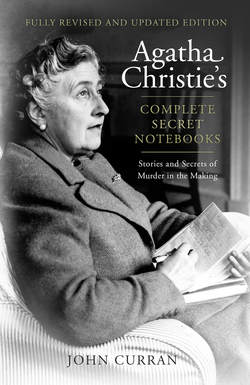Читать книгу Agatha Christie’s Complete Secret Notebooks - Агата Кристи, Agatha Christie, Detection Club The - Страница 42
Rule of Three
Оглавление‘One of the pleasures in writing detective stories is that there are so many types to choose from: the light-hearted thriller … the intricate detective story … and what I can only describe as the detective story that has a kind of passion behind it …’
An Autobiography
SOLUTIONS REVEALED
The ABC Murders • After the Funeral • Appointment with Death • The Body in the Library • Curtain: Poirot’s Last Case • Death in the Clouds • Death on the Nile • Endless Night • Evil under the Sun • 4.50 from Paddington • Hercule Poirot’s Christmas • The Hollow • Lord Edgware Dies • The Man in the Brown Suit; • ‘The Man in the Mist’ • ‘The Market Basing Mystery’ • The Mousetrap • The Murder at the Vicarage • ‘Murder in the Mews’ • The Murder of Roger Ackroyd • Murder on the Orient Express • The Mysterious Affair at Styles • One, Two, Buckle my Shoe • Ordeal by Innocence • A Pocket Full of Rye • Sparkling Cyanide • Taken at the Flood • They Came to Baghdad • They Do It with Mirrors • Three Act Tragedy • ‘The Unbreakable Alibi’ • ‘The Witness for the Prosecution’
‘Surely you won’t let Agatha Christie fool you again. That would be “again” – wouldn’t it?’ Thus read the advertisement, at the back of many of her early Crime Club books, announcing recent and forthcoming titles from the Queen of Crime. The first Crime Club novel bearing the now-famous hooded gunman logo, was Philip MacDonald’s The Noose in May 1930; Agatha Christie’s first Crime Club title, The Murder at the Vicarage, followed in October of that year. By then Collins had already published, between 1926 and 1929, five Christie titles – The Murder of Roger Ackroyd, The Big Four, The Mystery of the Blue Train, The Seven Dials Mystery and Partners in Crime – in their general fiction list. As soon as The Crime Club was founded, her’s was an obvious name to include and over the next half century she proved to be one of the most prolific authors – and by far the most successful – to appear under its imprint. This author/publisher relationship continued for the rest of her writing life, almost all of her titles appearing with the accompaniment of the hooded gunman.2
As the dustjacket on the first edition of The Murder at the Vicarage states, ‘The Crime Club has been formed so that all interested in Detective Fiction may, at NO COST TO THEMSELVES, be kept advised of the best new Detective Novels before they are published.’ By 1932 and Peril at End House, The Crime Club was boasting that ‘Over 25,000 have joined already. The list includes doctors, clergymen, lawyers, University Dons, civil servants, business men; it includes two millionaires, three world-famous statesmen, thirty-two knights, eleven peers of the realm, two princes of royal blood and one princess.’
This is the first edition title page of The Murder at the Vicarage, the first Agatha Christie title to appear under The Crime Club imprint on 13th October 1930.
And the advertisement on the first edition wrapper of The ABC Murders (1936) clearly states the Club’s aims and objectives:
The object of the Crime Club is to provide that vast section of the British Public which likes a good detective story with a continual supply of first-class books by the finest writers of detective fiction. The Panel of five experts selects the good and eliminates the bad, and ensures that every book published under the Crime Club mark is a clean and intriguing example of this class of literature. Crime Club books are not mere thrillers. They are restricted to works in which there is a definite crime problem, an honest detective process, with a credible and logical solution. Members of the Crime Club receive the Crime Club News issued at intervals.
As this suggests, not for nothing was the 1930s known as the Golden Age of detective fiction, an era during which the creation and enjoyment of a detective story was a serious business for reader, writer and publisher. All three took the elaborate conventions seriously. The civilised outrage that followed the publication of The Murder of Roger Ackroyd in 1926 showed what a serious breach of the rules its solution was considered at the time. So, while in many ways observing the so-called ‘rules’, and consolidating the image of a safe, cosy and comforting type of fiction, Agatha Christie also constantly challenged those ‘rules’ and, by regularly and mischievously tweaking, bending, and breaking them, subverted the expectations of her readers and critics. She was both the mould creator and mould breaker, who delighted in effectively saying to her fans, ‘Here is the comforting read that you expect when you pick up my new book but because I respect your intelligence and my own professionalism, I intend to fool you.’
But how did she fool her readers while at the same time retaining her vice-like grip on their admiration and loyalty? In order to understand how she managed this feat it is necessary to take a closer look at ‘The Rules’.
